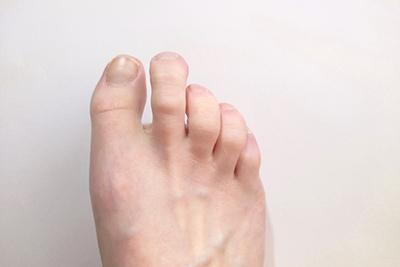Risk Factors for Hammertoes

- posted: May 19, 2024
Hammertoes is a condition in which the toes become stiff, rigid, and bent downward in a hammer-like position. The condition typically affects the second, third, and fourth toes and often causes pain and discomfort. Seeking treatment early on helps prevent hammertoes from becoming worse and requiring surgery. The experienced podiatrist Dr. Jesse Anderson at AAL Podiatry Associates in Suffolk & Norfolk, VA, treat hammertoes and will develop a custom treatment plan tailored to your symptoms and needs.
Symptoms of Hammertoes
A noticeable bend in the toes is the most obvious sign of having hammertoes, but several other symptoms could also develop. Additional symptoms of the condition include:
- Pain and discomfort
- Stiff or rigid toe joints
- Swollen or inflamed toe joints
- Development of corns or calluses on the toe joints
- Diminished flexibility in the toes
- Pain in the ball of the foot
- Burning sensation
- Redness
Risk Factors for Hammertoes
A common reason for the development of hammertoes is an imbalance between the tendons, ligaments, and muscles in the toes. The imbalance can cause the toe joint to become dislocated so that the toe bends downward in a hammer-like shape. Some common risk factors for developing hammertoes include:
- Injuring the toes or feet
- Family history of the condition
- Having arthritis, diabetes, or neuropathy
- Having flat feet or extremely high arches
- Having a long second toe that extends past the big toe
- Wearing tight or narrow footwear that cramps the toes
- Wearing shoes without enough arch support
- Getting older
Treatments for Hammertoes
Hammertoes do not heal on their own so it is important to seek treatment. Several nonsurgical methods are available for effectively treating the condition during the early stages when the toes are still somewhat flexible. Surgery could be needed if the condition is further along and the toes have become extremely stiff and rigid. Surgical methods might include tendon lengthening, toe joint fusion, or tendon transfer.
At our podiatry office in Suffolk & Norfolk, VA, hammertoes are treated using several different methods. One of our skilled providers will develop an appropriate treatment plan to correct your condition. Treatment options for hammertoes include:
- Toe splints to help realign dislocated toe joints
- Protective padding to minimize irritation from corns and calluses
- Custom orthotics to correct imbalances in the muscles, tendons, or ligaments
- Personalized footwear recommendations for shoes that do not cramp the toes
- Non-steroidal medications to reduce inflammation and relieve pain
- Special stretching and strengthening exercises for the feet
- Toe surgery
If you have developed hammertoes, we can help. Schedule a consultation with Dr. Anderson to discuss options for treating your hammertoes by calling AAL Podiatry Associates in Suffolk & Norfolk, VA. Call (757) 625-2962 for Norfolk or (757) 539-2098 for Suffolk.

- posted: May 19, 2024
Hammertoes is a condition in which the toes become stiff, rigid, and bent downward in a hammer-like position. The condition typically affects the second, third, and fourth toes and often causes pain and discomfort. Seeking treatment early on helps prevent hammertoes from becoming worse and requiring surgery. The experienced podiatrist Dr. Jesse Anderson at AAL Podiatry Associates in Suffolk & Norfolk, VA, treat hammertoes and will develop a custom treatment plan tailored to your symptoms and needs.
Symptoms of Hammertoes
A noticeable bend in the toes is the most obvious sign of having hammertoes, but several other symptoms could also develop. Additional symptoms of the condition include:
- Pain and discomfort
- Stiff or rigid toe joints
- Swollen or inflamed toe joints
- Development of corns or calluses on the toe joints
- Diminished flexibility in the toes
- Pain in the ball of the foot
- Burning sensation
- Redness
Risk Factors for Hammertoes
A common reason for the development of hammertoes is an imbalance between the tendons, ligaments, and muscles in the toes. The imbalance can cause the toe joint to become dislocated so that the toe bends downward in a hammer-like shape. Some common risk factors for developing hammertoes include:
- Injuring the toes or feet
- Family history of the condition
- Having arthritis, diabetes, or neuropathy
- Having flat feet or extremely high arches
- Having a long second toe that extends past the big toe
- Wearing tight or narrow footwear that cramps the toes
- Wearing shoes without enough arch support
- Getting older
Treatments for Hammertoes
Hammertoes do not heal on their own so it is important to seek treatment. Several nonsurgical methods are available for effectively treating the condition during the early stages when the toes are still somewhat flexible. Surgery could be needed if the condition is further along and the toes have become extremely stiff and rigid. Surgical methods might include tendon lengthening, toe joint fusion, or tendon transfer.
At our podiatry office in Suffolk & Norfolk, VA, hammertoes are treated using several different methods. One of our skilled providers will develop an appropriate treatment plan to correct your condition. Treatment options for hammertoes include:
- Toe splints to help realign dislocated toe joints
- Protective padding to minimize irritation from corns and calluses
- Custom orthotics to correct imbalances in the muscles, tendons, or ligaments
- Personalized footwear recommendations for shoes that do not cramp the toes
- Non-steroidal medications to reduce inflammation and relieve pain
- Special stretching and strengthening exercises for the feet
- Toe surgery
If you have developed hammertoes, we can help. Schedule a consultation with Dr. Anderson to discuss options for treating your hammertoes by calling AAL Podiatry Associates in Suffolk & Norfolk, VA. Call (757) 625-2962 for Norfolk or (757) 539-2098 for Suffolk.
